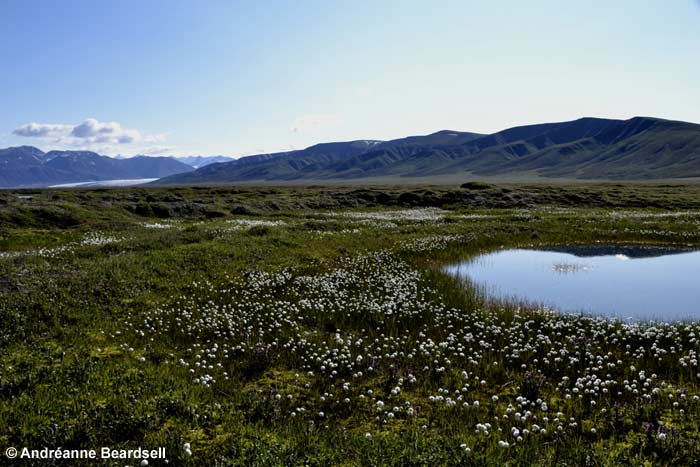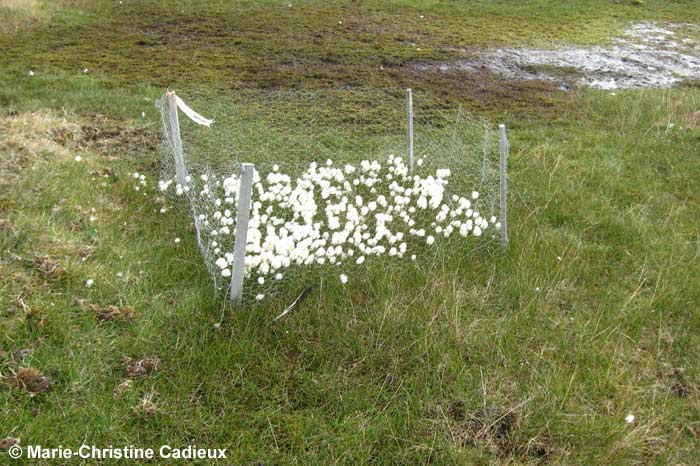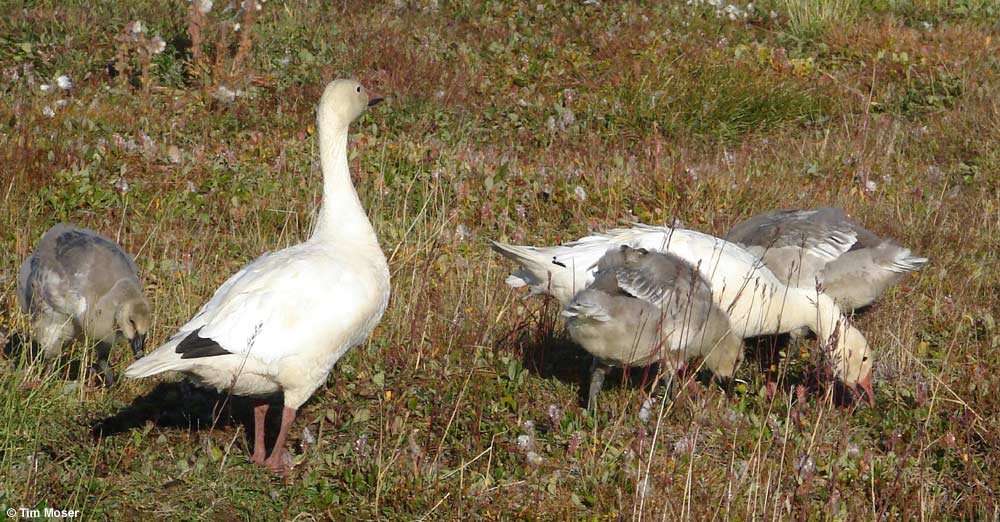
Bylot Island has habitats of rare plant productivity for an Arctic ecosystem and this exceptional productivity attracts and sustains a wide variety of breeding migratory bird species, including herbivores such as the cackling goose, the rock ptarmigan and the greater snow goose. With more than 100,000 birds present each summer, the greater snow goose is the most abundant herbivore of the island. Upon their arrival in spring, snow geese feed on the underground parts of various tundra plants. Later in the summer, during the brood-rearing period, goose families prefer to feed in wetlands, where they can graze on fresh grasses and sedges. Since the 1960s, the greater snow goose has seen its population increased drastically. One of the most concerning consequence of such population expansion is the destruction, by overgrazing, of the Arctic habitats they use during the breeding season. Indeed, destruction of large marshes areas by the lesser snow goose has been observed in La Pérouse Bay, on the west coast of Hudson Bay (Canada). Such dramatic impacts are not observed on Bylot Island yet, but in order to identify the first signs of detrimental effects, our project closely monitors the wetlands productivity (how much plant mass is produced) and the goose grazing impacts in those wetlands since 1990 in the Qarlikturvik Valley (the main brood-rearing area for goose families) and since 1998 at the goose nesting colony. Each summer, before snowmelt, exclosures are built in wetland areas of the island to keep geese from grazing the vegetation. At the end of each summer, we sample the vegetation inside and outside exclosures to estimate the wetland productivity and goose grazing impact. The full dataset of our wetland monitoring on Bylot Island is available on NordicanaD.
Wetland productivity

Wetlands productivity is evaluated by measuring the amount of above-ground biomass (mass of vegetation growing above the ground) in ungrazed areas (inside exclosures). When evaluating this productivity on Bylot Island, plants are divided in three large groups of graminoid plants: Eriophorum (cottongrass, the preferred plant of geese), grasses (mainly Dupontia or tundra grass, another plant favored by geese) and Carex. The productivity of each plant group varies from year to year, influenced by fluctuating summer climatic conditions. Indeed, due to the short summer, the annual growth of plants in the Arctic is very sensitive to summer air temperature, which has increased over the past decades (see long-term climate observations for more details).
The plant production of arctic wetlands ranges from 20 to 100 g/m2 depending on the latitude, with High-Arctic sites having lower productivity compared to low Arctic wetlands. Since 1990, the overall above-ground biomass of graminoid plants averages 51 g/m2 in the Qarlikturvik Valley. Grasses species accounts for 61% of this biomass, Eriophorum for 32% and Carex for 7% of the total graminoids biomass. Since 1990, the biomass of graminoid plants has shown an increasing trend in the Qarlikturvik Valley. Indeed, since 1998, the plant productivity has been generally higher than the long-term average.
| Plant production in the wetlands of the Qarlikturvik Valley (main brood-rearing area). There is no productivity data in 1992, 2020, 2021 and 2024. |
At the goose nesting colony, plant productivity of graminoid plants averaged 38 g/m2 from 1998 to 2010 (compared to 55 g/m2 for the same period in the Qarlikturvik Valley). Grasses species, mostly Dupontia, accounts for half of this biomass, while Eriophorum species represented 46% and Carex 4%. Due to drought conditions, half of the exclosures at the goose nesting colony changed location in 2011 which prohibits a comparison of long-term trend in plant production at this site. The graminoid biomass since 2011 averages 106 g/m2, most of it represented by Eriophorum (64%), and grasses species (35%) with very little Carex (1%).
 | |
| Plant production in the wetlands of the goose nesting colony. Half of the exclosures had to be moved to a new site in 2011, which explains why the figure is split and the long-term average are calculated separately before/after 2011. There is no productivity data in 2020, 2021, 2023 and 2024. | |
Goose grazing impact
On Bylot Island, goose grazing impact is calculated as the proportion of above-ground plant mass grazed by greater snow geese (difference between the amount of vegetation inside and outside exclosures, i.e. ungrazed vs. grazed). This impact varies from year to year and is influenced by the number of snow geese breeding on the island. Since 1990, greater snow geese removed, on average, 32% of the annual above-ground biomass in the wetlands of the Qarlikturvik Valley. The year during which the greater impact was noticed is 1993, when geese removed 60% of the above-ground biomass in the Qarlikturvik Valley. This year also corresponds to a peak in the Bylot Island greater snow goose population. Two other years also stand out when we failed to detect any impact of goose grazing on the wetland vegetation on the brood-rearing grounds (i.e. 2004 and 2010). In 2004, heavy rainfall received in July flooded the wetlands of the Qarlikturvik Valley which prevented geese from grazing much of the plants produced that year. In 2010, the presence of snowy owls on the island resulted in geese nesting in small clusters around owl nests, away from their usual nesting site. Hence, even though plant productivity was high in 2010, geese may have used isolated wetland patches away from their traditional brood-rearing areas. In the main nesting colony, geese remove about 27% of the total above-ground biomass. This is similar to what is observed in the Qarlikturvik Valley for the same period (i.e. 28% of plant biomass removed since 1998). So far, we have seen no clear evidence that greater snow goose grazing has a negative impact on the plant production in wetlands on Bylot Island.

| Goose grazing impact in the wetlands of the Qarlikturvik Valley (main brood-rearing area) and the goose nesting colony. There is no grazing impact data in the Qarlikturvik Valley in 1992, at both sites in 2020, 2021 and 2024 and at the goose nesting colony in 2023. |
Climate change and the mismatch in food availability
As herbivores, geese select high quality graminoid plants in their diet to meet their nutritional requirements throughout the year. During the summer, newly hatched goslings need to increase their body mass by more than twenty times in less than two months to survive the migration down south. To do so, they have to ingest high amount of plants rich in proteins. Hence, breeding geese have to time their laying date to coincide the hatching of their goslings with the peak in quality and availability of plants, which usually occurs in early July. However, in years when spring begins early in the Arctic, geese are not always able to arrive at the optimal time on their breeding grounds because environmental conditions vary at each stopover sites along their migration route. During those years, on Bylot Island, goslings often hatch after the peak of plant quality which advances with warmer temperatures. This mismatch results in reduced body mass and size for goslings at fledging. In the Arctic, the growing season of plants is short (<100 days) and starts as soon as the snow melts. As air temperatures have been warming in the Arctic over the past few decades, this type of mismatch between geese and their food could become more recurrent in the future and have negative long-term consequences on the greater snow goose population.
